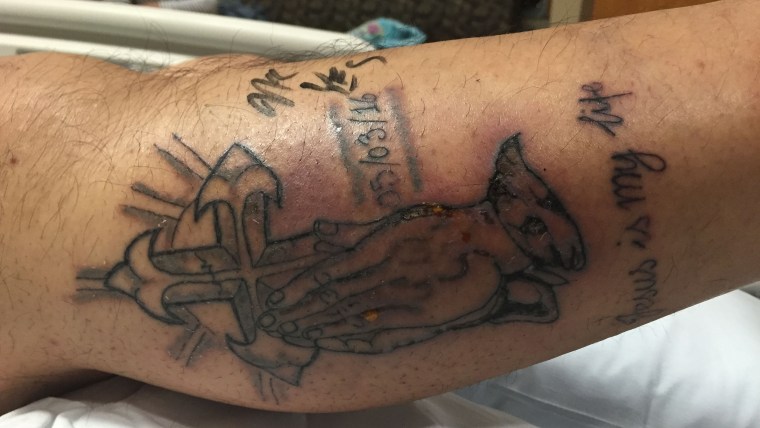The death of a 31-year-old man who went swimming within days of getting a tattoo underscores the importance of properly taking care of your body art during the weeks after you’ve been inked, a new report suggests.
“The lesson isn’t that you shouldn’t get a tattoo,” said Dr. Nicholas Hendren, the lead author of the report and an internal medicine resident at the Parkland Health & Hospital System and University of Texas Southwestern Medical Center. “It’s that you have to take care of it. If you get stitches you probably wouldn’t go swimming in a pond or lake or the ocean. And you shouldn’t with a tattoo for at least one or two weeks."
Until then, think of the tattoo as an open wound at risk of infection, Hendren told TODAY.

The Latino man had gone swimming in the Gulf of Mexico five days after getting a tattoo on his right calf, according to the report which was published in BMJ Case Reports. Two days later he started to experience chills and a fever, and his legs developed a reddish tinge. The next day, excruciating pain in both his legs and feet sent him to the Parkland Memorial Hospital.
Just hours after he was admitted, the man’s legs started to develop purplish blotches that were lined with black, clear signs of a virulent infection, most likely with a bacteria named Vibrio vulnificus, which is associated with necrotising fasciitis commonly found in the Gulf of Mexico waters.
'Thrives on iron'
While it’s not unusual for people to be exposed to the bacteria when swimming in the Gulf waters or eating oysters, virulent infection isn’t commonplace. In this case, the man had liver disease that made it hard for his body to metabolize iron. That meant he had a tendency to accumulate iron in his body and this particular bacterium “thrives on iron,” Hendren said. “It grows viciously and then the body’s immune response is way out of proportion.”
The end result can be septic shock. Studies have shown that only 10 percent of patients with liver disease who become infected with this bacterium survive. The man died two months after his admission to the hospital from complications related to cirrhosis, renal failure and the skin lesions.
But even people with healthy livers should be cautious about infected tattoos, Hendren said.
Tattoos leave open wounds that have to be kept clean until they are completely healed. And while V. vulnificus rarely kills people with healthy livers, there are plenty of other bacteria lurking in our environment, including the deadly methicillin-resistant Staphylococcus aureus, or MRSA, Hendren said.
A case like this should serve as a cautionary tale to those who have just gotten a tattoo, said Pat Sinatra, a founding member and past president of the Alliance of Professional Tattooists. Once you’ve gotten a tattoo, you “receive some sort of written after-care instructions — not just written, but also verbal,” Sinatra said.
The problem is, “usually when someone is finished they don’t want to know anything about caring about it and they also don’t want to stay in the chair for another moment,” Sinatra said. That’s why the written instructions are so important.
Safety precautions and danger signs
Sinatra suggested precautions everyone with a new tattoo should follow during the two weeks after being inked:
- Avoid submerging the tattoo in water. “That’s true whether you’re swimming in a chlorinated pool or in the ocean or a lake, since you are subject to not only bacteria invasion, but also amoebas,” Sinatra said. “If it’s in the water you can have it in your body.”
- Wash your hands carefully before and after you touch your tattoo.
- Keep your tattoo out of the sun. “Sun has a most damaging effect on new tattoos,” Sinatra said. “It can also cause them to fade. And when it’s fully healed we recommend a sun block with SPF 15 or greater.”
Seek immediate attention if your notice your new tattoo is:
- turning red or its outer edges are turning red
- if it’s bubbling or oozing
- feels hot
Those are all danger signs of an infection that could turn into something worse.
“And since we are not doctors don’t return to the tattoo shop," Sinatra said. "Go to your doctor."